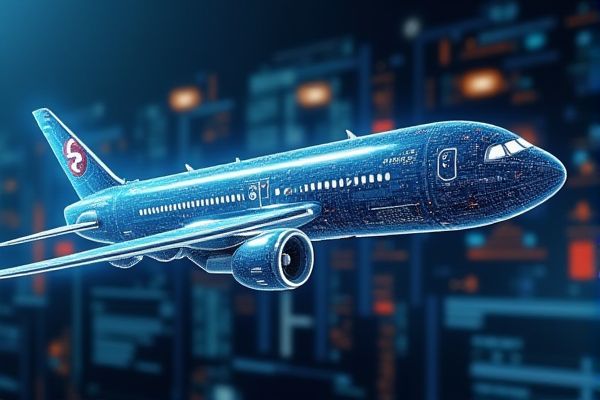
AI enhances aerospace technology through predictive maintenance, optimizing aircraft performance by analyzing vast amounts of data to foresee potential mechanical failures. Machine learning algorithms enable real-time decision-making in air traffic control, improving safety and efficiency in managing airspace. Simulation systems powered by AI facilitate the design and testing of new aircraft, shortening development cycles and reducing costs. Autonomous systems, including drones and spacecraft, benefit from advanced AI for navigation, data collection, and mission execution, paving the way for innovative applications in both commercial and defense sectors.
AI usage in aerospace technology
Predictive Maintenance
AI can enhance predictive maintenance in aerospace technology by analyzing large datasets from aircraft operations. This analysis allows for the early identification of potential failures, reducing downtime and maintenance costs. Companies like Boeing are leveraging AI to improve aircraft reliability by predicting when components need servicing. The integration of AI tools can increase operational efficiency and safety in the aerospace industry.
Flight Path Optimization
AI can significantly enhance flight path optimization in aerospace technology by analyzing vast amounts of data to identify the most efficient routes. For instance, airlines like Delta Air Lines are equipped to reduce fuel consumption and emissions through AI-driven algorithms. This technology enables real-time adjustments based on weather conditions, air traffic, and other variables, potentially leading to safer flights. The chance for reduced operational costs and improved passenger experience makes AI a valuable asset in this field.
Autonomous Drones
AI usage in aerospace technology has the potential to enhance the capabilities of autonomous drones, enabling them to perform complex tasks more efficiently. For instance, companies like Boeing are exploring AI-driven decision-making systems for drone navigation and obstacle avoidance. The integration of AI can improve data analysis in real-time, allowing drones to adapt to changing environments. This advancement may result in cost savings and increased operational safety in various applications such as cargo delivery and surveillance.
Satellite Image Analysis
AI applications in aerospace technology, such as satellite image analysis, can enhance data interpretation and decision-making processes. By utilizing machine learning algorithms, companies like Boeing can improve the accuracy of terrain mapping and change detection. This technology holds the potential for better resource management and environmental monitoring. The integration of AI may result in increased efficiency and reduced operational costs in various aerospace operations.
Air Traffic Management
AI offers significant advantages in aerospace technology, particularly in Air Traffic Management. By utilizing machine learning algorithms, air traffic controllers can optimize flight paths, potentially reducing delays and fuel consumption. For instance, systems developed by NASA incorporate AI to predict air traffic flow, enhancing safety and efficiency. Embracing these technologies could lead to substantial operational improvements for aviation institutions worldwide.
Fuel Efficiency Modeling
AI can enhance fuel efficiency modeling in aerospace technology by analyzing vast datasets to identify optimal flight paths and reduce emissions. For example, Boeing has utilized machine learning algorithms to predict fuel consumption patterns based on historical flight data. This approach not only improves operational efficiency but also contributes to sustainability goals within the industry. The potential for cost savings and reduced environmental impact makes AI a valuable tool for aerospace companies.
Manufacturing Process Automation
AI has the potential to greatly enhance aerospace technology by optimizing design processes and improving safety measures. Through predictive maintenance algorithms, flaws in aircraft components can be identified before they lead to failures, which exemplifies how institutions like Boeing leverage such technologies. In manufacturing process automation, AI can streamline operations by analyzing data to predict bottlenecks and minimize waste. The implementation of AI-driven robotics might increase production speed while maintaining high quality in aerospace components.
Virtual Testing and Simulation
AI usage in aerospace technology facilitates advancements in virtual testing and simulation, allowing for more efficient design processes. By employing sophisticated algorithms, engineers can predict aircraft performance and safety under various conditions, which is crucial for institutions like NASA. This technology also reduces costs associated with physical testing, providing a chance for quicker iterations and innovations. As a result, the aerospace sector can leverage AI to improve overall project timelines and outcomes.
Fault Detection Systems
AI is enhancing fault detection systems in aerospace technology by improving the identification of anomalies in aircraft systems. These systems leverage machine learning algorithms to analyze data from various sensors, increasing the likelihood of early problem detection. For instance, companies like Boeing are investing in AI-powered predictive maintenance tools to optimize aircraft performance and safety. The integration of AI could potentially lead to significant reductions in maintenance costs and unscheduled downtimes.
Pilot Assistance Systems
AI in aerospace technology has the potential to enhance Pilot Assistance Systems significantly. By leveraging machine learning algorithms, these systems can provide real-time data analysis and decision support, improving flight safety and operational efficiency. For example, companies like Boeing are exploring AI-driven tools to assist pilots in managing complex flight scenarios. This integration may lead to reduced pilot workload and improved overall situational awareness in various flight conditions.
 techknowy.com
techknowy.com